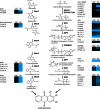Coupling deep transcriptome analysis with untargeted metabolic profiling in Ophiorrhiza pumila to further the understanding of the biosynthesis of the anti-cancer alkaloid camptothecin and anthraquinones
- PMID: 23503598
- PMCID: PMC3653139
- DOI: 10.1093/pcp/pct040
Coupling deep transcriptome analysis with untargeted metabolic profiling in Ophiorrhiza pumila to further the understanding of the biosynthesis of the anti-cancer alkaloid camptothecin and anthraquinones
Abstract
The Rubiaceae species, Ophiorrhiza pumila, accumulates camptothecin, an anti-cancer alkaloid with a potent DNA topoisomerase I inhibitory activity, as well as anthraquinones that are derived from the combination of the isochorismate and hemiterpenoid pathways. The biosynthesis of these secondary products is active in O. pumila hairy roots yet very low in cell suspension culture. Deep transcriptome analysis was conducted in O. pumila hairy roots and cell suspension cultures using the Illumina platform, yielding a total of 2 Gb of sequence for each sample. We generated a hybrid transcriptome assembly of O. pumila using the Illumina-derived short read sequences and conventional Sanger-derived expressed sequence tag clones derived from a full-length cDNA library constructed using RNA from hairy roots. Among 35,608 non-redundant unigenes, 3,649 were preferentially expressed in hairy roots compared with cell suspension culture. Candidate genes involved in the biosynthetic pathway for the monoterpenoid indole alkaloid camptothecin were identified; specifically, genes involved in post-strictosamide biosynthetic events and genes involved in the biosynthesis of anthraquinones and chlorogenic acid. Untargeted metabolomic analysis by Fourier transform ion cyclotron resonance mass spectrometry (FT-ICR-MS) indicated that most of the proposed intermediates in the camptothecin biosynthetic pathway accumulated in hairy roots in a preferential manner compared with cell suspension culture. In addition, a number of anthraquinones and chlorogenic acid preferentially accumulated in hairy roots compared with cell suspension culture. These results suggest that deep transcriptome and metabolome data sets can facilitate the identification of genes and intermediates involved in the biosynthesis of secondary products including camptothecin in O. pumila.
Keywords: Anthraquinone; Camptothecin; Hairy root; Metabolome; Ophiorrhiza pumila; Transcriptome.
Figures



Similar articles
-
Suppression of camptothecin biosynthetic genes results in metabolic modification of secondary products in hairy roots of Ophiorrhiza pumila.Phytochemistry. 2013 Jul;91:128-39. doi: 10.1016/j.phytochem.2012.04.019. Epub 2012 May 30. Phytochemistry. 2013. PMID: 22652243
-
Camptothecin biosynthetic genes in hairy roots of Ophiorrhiza pumila: cloning, characterization and differential expression in tissues and by stress compounds.Plant Cell Physiol. 2003 Apr;44(4):395-403. doi: 10.1093/pcp/pcg051. Plant Cell Physiol. 2003. PMID: 12721380
-
Transcription Factor OpWRKY3 Is Involved in the Development and Biosynthesis of Camptothecin and Its Precursors in Ophiorrhiza pumila Hairy Roots.Int J Mol Sci. 2019 Aug 16;20(16):3996. doi: 10.3390/ijms20163996. Int J Mol Sci. 2019. PMID: 31426351 Free PMC article.
-
Recent studies on chemical constituents of Ophiorrhiza plants.J Nat Med. 2022 Sep;76(4):748-755. doi: 10.1007/s11418-022-01640-3. Epub 2022 Jul 28. J Nat Med. 2022. PMID: 35902551 Free PMC article. Review.
-
Biotechnology for micropropagation and camptothecin production in Ophiorrhiza sp.Appl Microbiol Biotechnol. 2022 Jun;106(11):3851-3877. doi: 10.1007/s00253-022-11941-y. Epub 2022 May 21. Appl Microbiol Biotechnol. 2022. PMID: 35596786 Review.
Cited by
-
De novo genome assembly of Camptotheca acuminata, a natural source of the anti-cancer compound camptothecin.Gigascience. 2017 Sep 1;6(9):1-7. doi: 10.1093/gigascience/gix065. Gigascience. 2017. PMID: 28922823 Free PMC article.
-
Allelopathy as an evolutionary game.Plant Direct. 2022 Feb 11;6(2):e382. doi: 10.1002/pld3.382. eCollection 2022 Feb. Plant Direct. 2022. PMID: 35169675 Free PMC article.
-
Transcriptome Analysis of Different Tissues Reveals Key Genes Associated With Galanthamine Biosynthesis in Lycoris longituba.Front Plant Sci. 2020 Sep 16;11:519752. doi: 10.3389/fpls.2020.519752. eCollection 2020. Front Plant Sci. 2020. PMID: 33042169 Free PMC article.
-
Next Generation Sequencing and Transcriptome Analysis Predicts Biosynthetic Pathway of Sennosides from Senna (Cassia angustifolia Vahl.), a Non-Model Plant with Potent Laxative Properties.PLoS One. 2015 Jun 22;10(6):e0129422. doi: 10.1371/journal.pone.0129422. eCollection 2015. PLoS One. 2015. PMID: 26098898 Free PMC article.
-
Secondary metabolites from Rubiaceae species.Molecules. 2015 Jul 22;20(7):13422-95. doi: 10.3390/molecules200713422. Molecules. 2015. PMID: 26205062 Free PMC article. Review.
References
-
- Afendi FM, Okada T, Yamazaki M, Hirai-Morita A, Nakamura Y, Nakamura K, et al. KNApSAcK family databases: integrated metabolite–plant species databases for multifaceted plant research. Plant Cell Physiol. 2012;53:e1. - PubMed
-
- Aharoni A, Ric de Vos CH, Verhoeven HA, Maliepaard CA, Kruppa G, Bino R, et al. Nontargeted metabolome analysis by use of Fourier transform ion cyclotron mass spectrometry. OMICS. 2002;6:217–234. - PubMed
-
- Aimi N, Hoshino H, Nishimura M, Sakai S-i, Haginiwa J. Chaboside, first natural glycocamptothecin found from Ophiorrhiza pumila. Tetrahedron Lett. 1990;31:5169–5172.
-
- Aimi N, Nishimura M, Miwa A, Hoshino H, Sakai S-i, Haginiwa J. Pumiloside and deoxypumiloside; plausible intermediates of camptothecin biosynthesis. Tetrahedron Lett. 1989;30:4991–4994.
Publication types
MeSH terms
Substances
Grants and funding
LinkOut - more resources
Full Text Sources
Other Literature Sources
Research Materials

